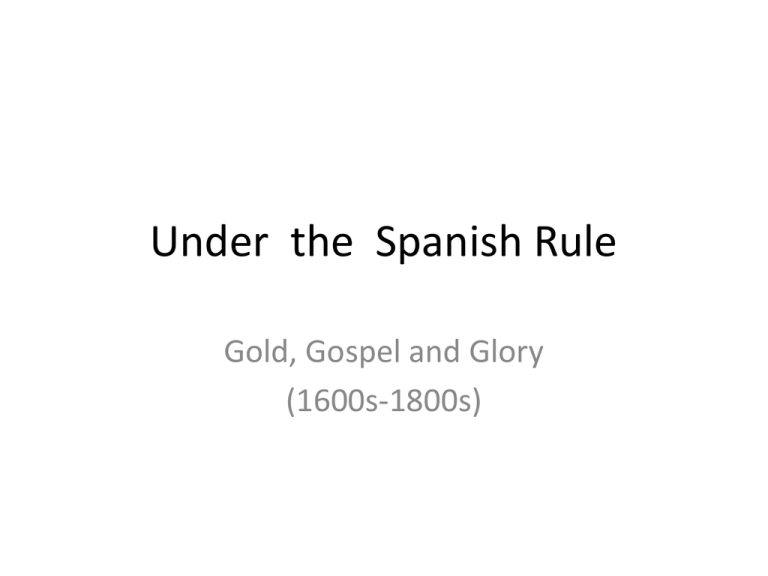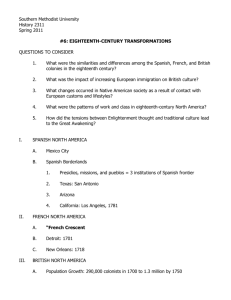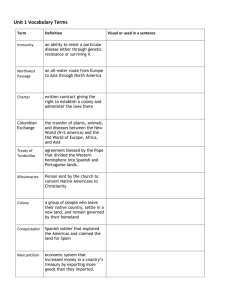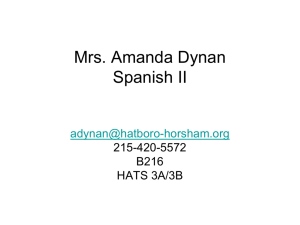Under the Spanish Rule
advertisement

Under the Spanish Rule Gold, Gospel and Glory (1600s-1800s) Reasons for Spanish Colonization • -King Charles I sent an expedition to the Spice Islands in Asia bec. spices were profitable (gold); to Christianize the natives (gospel); and to showcase power to the world (glory) • 1. “discovery” was made under the auspices of Spain • 2. Spain claimed the Philippines by right of “discovery” and by right of actual conquest, therefore a crown colony Social Structure Pre-colonial period • With social mobility Spanish period • Big class gapdwithout social mobility Reduccion (Plaza complex) Pre-colonial Spanish period Reduccion plan • -by Fr. Juan de Plasencia • Those who refused to obey were labelled bandits or tulisanes • Bandidos, taga-bayan/taga-bundok divide “under peals of the bell” • -bajo de las campanas • -spread Christianity by the “peals of the bell” • Plaza complex as a politico-religious structure of the colonial govt to effectively control the natives Administrative Organization (centralized form of govt) 18th century • -Spanish crown governed indirectly through the Consejo dela Indias or Council of the Indies • Governor-General heads (had the cumplase: “I obey but not comply” • Vice-royal patron over religious affairs • Commander-in-chief of the colonial army 19th century • Spanish crown governed directly through the Ministry of the Colonies or Ministerio de Ultamar • no law-making body (legislative) • Royal Audiencia as the judicial power Local government Pacified provinces City govt (Ayuntamiento ) • ALCALDE MAYOR ( PROV’L GOVT) • -his right to monopolized trade (indulto comercio) made him corrupt and rich • -had the power to judge in courts GOBERNADORCILLO (little governor); also called capitan/capitan municipal (mayor) CABEZA DE BARANGAY • -governed by a city council or the cabildo; (Cebu and Mla) had the city hall where there were the• Two alcaldes • 12 regidores (councillors) • Chief of Police • City secretary • Other lesser officials • Cabeza de barangay (datu/principalia) “Frailocracia”-Graciano Lopez Jaena • Union of Church and State- principle upon which the Spanish colonial government in the Philippines was founded • -supremacy of the friars • -friar was the supervising representative of the Spanish govt for all local affairs (ruler of the town, school inspector, health inspector, prison inspector, inspector of the accounts of the governadorcillos and cabezas de barangay Weaknesses • 1. bribery, graft and corruption- Gov. gen could award positions to his favorites; control and influence over colonial affairs of other officials; widespread selling of lower positions to highest bidders • 2. inefficient- many govt officials were appointed not on the basis of merit but the ability to but position • 50 Governor Generals during Spanish period changing hands for one year – at most Economic institutions • 1. encomienda system- a system where lands were subdivided into parcels, together with its inhabitants, entrusted to Spanish encomenderos as a reward in helping colonize the country; abolished in 1674 due to complains of abuses • 2. taxation-Filipinos paid in cash called reales; encomenderos reaped huge profits and became wealthy; cedula as a form of taxation; bandala-forced selling of agricultural products to the Spaniards • 3. forced labor (polo y servicio) – laborers were called polistas; can pay a falla or exemprion fee, also a source of corruption • 4. Galleon Trade- early trade in Manila and Acapulco, Mexico that commenced in 1565; basically a trade between the Spaniards and the Chinese in Manila and counterparts in Mexico





